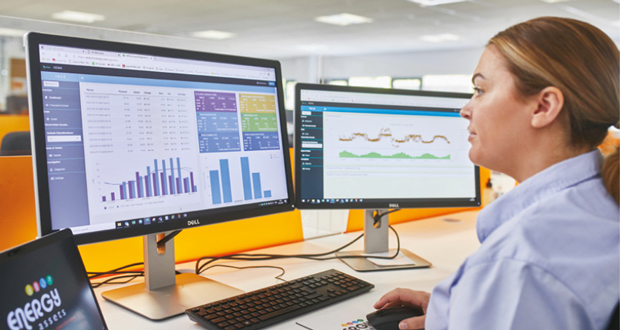 The latest machine learning tools are helping to optimise energy efficiency and reduce emissions across a retailer’s portfolio of stores. David Sing, Managing Director (Assets) of Energy Assets
The latest machine learning tools are helping to optimise energy efficiency and reduce emissions across a retailer’s portfolio of stores. David Sing, Managing Director (Assets) of Energy Assets
The estimated 1.5 million industrial and commercial (I&C) buildings in England and Wales account for around one third of all UK carbon emissions from total building stock. But there has been criticism that the government’s energy strategy has done little to incentivise building energy performance.
The good news is that there are now digital tools available to help managers bear down on consumption. Moreover, the value of this data will only increase with the Market-wide Half-Hourly settlement (MWHH) reform due by 2025, which will enhance opportunities for demand side response incentives and preferential time of use tariffs.
The question for energy and sustainability managers is where best to invest time and resources to bear down on energy consumption and reduce carbon emissions?
At one level, this means optimising energy metering, consumption monitoring and data insights, at another it means applying advanced technologies, such as machine learning and artificial intelligence to drive out waste. Getting all these systems working in harmony is critical to optimising energy efficiency and reducing carbon emissions.
For managers, this means:
- Capturing consumption data in granular detail via automated meter reading systems
- Monitoring and analysing data through advanced AM&T portals , and setting automated alerts for unusual patterns of behaviour
- Applying advanced tools such as machine learning and artificial intelligence to identify efficiency opportunities
This will not only help bear down on cost at a time of spiralling energy bills, it will also enable carbon reduction strategies and actions linked to Energy Savings Opportunity Scheme (ESOS) targets.
DIGITAL SYSTEMS
Machine learning uses artificial intelligence (AI) to automatically learn about and improve energy consumption. It does this by assimilating half-hourly meter data and interpreting it in the context of operations and external factors (weather, occupancy levels). This creates ‘fingerprints’ of consumption – and, using AI, the system then progressively learns what best performance looks like. And because the system is smart, it can learn to ignore outcomes that are irrelevant, mistaken or due to bad data.
Crunching data on this scale manually would require an army of analysts – but with machine learning, this can be achieved in quick time, and lead to a priority action list based on real world data and comparative building analysis.
Often, it’s a question of spotting improvement opportunities hiding in plain sight, such as equipment running needlessly or heating controls incorrectly set – and machine learning is the perfect tool to do that.
RETAIL SOLUTION
One of Britain’s best-known retail brands is turning to machine learning to help optimise energy efficiency and reduce emissions across its portfolio of stores.
Central England Co-operative (CEC), which holds three Carbon Trust Standards for meeting carbon, waste and water targets, is now focused on achieving carbon neutrality by 2030 – and sees AI as a key weapon in its armoury.
In step with this objective, CEC is partnering with AMR DNA to optimise energy performance across its entire building estate.
This AI-based approach provides Rob Godson, CEC’s Energy and Environment Lead, with both near-real time consumption data and a smart tool that progressively optimises energy efficiency in each building.
“What AMR DNA gives us is a granular understanding of how our entire estate is performing from an energy perspective,” says Godson. “The software automatically overlays half-hourly metered consumption data with unusual energy spikes and their root causes. Issues that would previously have taken many hours of manual intervention to analyse can now be identified automatically – and quickly resolved.”
CEC adopted the approach having generated a 206 per cent return on investment in a pilot project that identified and eradicated energy waste. Today, it’s a process helping CEC to continue its impressive track record of energy efficiency, having reduced electricity usage by 51 per cent and gas consumption by 58 per cent since 2010.
“Using AMR DNA, we’re able to monitor energy performance site by site and benchmark efficiency and carbon emissions on a like-for-like basis, whether it’s a convenience outlet, large store or funeral service. As our datasets grow, these insights will become increasingly valuable in helping us frame the science-based targets that will underpin our journey to carbon neutrality and Net Zero.”
SMART ANALYTICS
The software also takes account of changes in store operations, for example when new freezer equipment is installed or if a site moves to 24-hour opening. This means that only exceptional events outside the new ‘normal’ are flagged. It’s also possible to model multiple building operation scenarios to inform better consumption forecasting and strategic planning.
Says Godson: “Our goal as a co-operative society is carbon neutrality by 2030, to be achieved through a mix of energy efficiency actions, waste reduction and capital investment.
“While there are clearly business and productivity drivers for efficiency gains, we also want to be contributors to the culture shift we see in our communities towards more sustainable operations. Thanks to the granular data now at our disposal, we’re better placed than ever before both to bear down on direct carbon emissions and to shape the science-based targets that will guide CEC to a carbon neutral future.”





